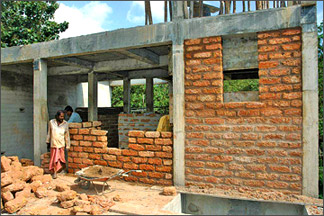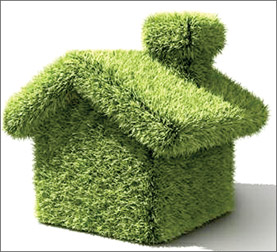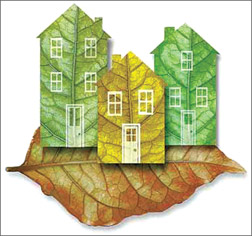|
Magazine
If something still has some value, better not discard
it:
Keen on green
Aditha Dissanayake
 Remember
old Mother Hubbard who lived in a shoe? Remember the cottage made of
bread and cake where lived a wicked witch in Hansel and Gretel? Things
are not that different in the real world either. If you happen to visit
Boston, Massachusetts, you will come across the house built by Elis F.
Stenman entirely from old newspapers. Near the frontier between
Argentina and Brazil there is said to be a house built with used plastic
bottles and Tetrapak cartons. Closer to home, Professor Sarath Kotagama
lives in an abode built by Architect Kapila Sugathadasa, where 70 to 80
percent of the building material happens to be the “refuse” of other
people’s houses. Remember
old Mother Hubbard who lived in a shoe? Remember the cottage made of
bread and cake where lived a wicked witch in Hansel and Gretel? Things
are not that different in the real world either. If you happen to visit
Boston, Massachusetts, you will come across the house built by Elis F.
Stenman entirely from old newspapers. Near the frontier between
Argentina and Brazil there is said to be a house built with used plastic
bottles and Tetrapak cartons. Closer to home, Professor Sarath Kotagama
lives in an abode built by Architect Kapila Sugathadasa, where 70 to 80
percent of the building material happens to be the “refuse” of other
people’s houses.
Seemingly echoing Prof Kotagama’s doctrine of “refuse, reduce,
recycle, reuse”, judging by the number of antique shops lining the
roadsides these days, displaying old doors, windows, bricks, tiles,
joists and soffit (to use builder’s jargon), all waiting to be given a
new life in new ways, it is evident that building one’s home using
salvage material is fast becoming a fad. Even as (real)
environmentalists christen these “doing as the joneses do” types as
accidental saviors of planet earth, who are we to complain if this means
saving earth’s dwindling resources?
Yet, according to Architect Vijitha Basnayake, using recycled
material for new buildings can hardly be called a fad, well, not a new
one anyway. “Recycling is nothing new”. Explains Basnayake. “Recycled
material were used even in ancient buildings. Romans used recycled
materials of older Greek buildings in their constructions. King
Nissankamalla used material taken from early buildings in his own
constructions in Polonnaruwa”.
Basnayake, who has used recycled material in 70 percent of the
buildings he created, believes money can be saved in more ways than one
when you fall back on used housing material. A recycled brick, for
example, is half the price of a new brick and financial costs can be
further minimized by using unconventional used materials such as
“discarded cable trunking” for the floors.

Kabok walls |

Windows made from recycled wood |
He dismisses the view that going green might mean the construction
work will take more time to complete with the assurance there is no
difference in the time factor and that “No extra time is required”. The
only negative point he sees in turning green and using recycled material
when building your home is the fact that “some antique dealers and
builders encourage people to demolish nice old buildings to take the
beautiful old building components. This is a big loss. Using antiques
and reusing building materials are two different things.”
Rarity
In other words, what ought to be considered as recycled material
should be, not the antiques, that have acquired a prestige of their own
because of rarity, but the material that belong to the middle ground,
the doors, bricks, and timber that are not new and have not acquired the
status of being “antique”.
Listen to Chandana Ranathunga, a constructor with over ten years
experience in the building industry, who recently completed a three
storied house in Battaramulla where 80 percent of the material used was
taken from a house that was about to be demolished, and you would think
nothing could be more satisfying, economical and fun than reusing old
building materials to build a new house.
“It is satisfying to know every effort, no matter how small, can
still help a lot in saving our only earth. Using recycled items is one
way of saving the remaining natural resources,” explains Ranathunga and
adds “when it comes to finances, it is less expensive when you use
recycled material. Here in Sri Lanka, most old buildings were made of
kabok and I know from experience that these kabok bricks are hardier
than the engineering bricks used in conventional constructions.” But
what about the stigma attached to the material obtained from old,
deteriorating houses? The bad spirits that might come with the used
doors and windows, (the vass dos) which might cause harm to the dwellers
of the new house?
Ranathunga throws his head back and laughs. “This is all bunkum. I
have used recycled material to renovate my own home and nothing bad has
happened to me”.(Touchwood!). The house he built for a client in
Battaramulla, at first glance looks like any other house in the
vicinity, but when he explains where every part came from, it is somehow
hard to believe that everything from the wooden gate to the cabok on the
walls, to the railings on the staircase are the salvaged materials from
a knocked down house in Kaduwela.
This is surely the best method to adopt if you too are thinking of
building a house of your own in the near future. Why allow houses and
old buildings to be smashed to smithereens when there is so much to be
gained in reusing them to construct a new dwelling? And when you do, you
will not only be saving money, but preventing deforestation as the
virtue of recycling used building materials lies in diminishing the need
for the building industry to recreate it.
All of the energy that is spent in manufacturing can be saved. The
raw materials that would be drawn from the earth can be saved. And at
the end of the day, even though when you enter the sitting room of your
new house built from earth-friendly old material you might get the
pleasant yet uncanny feeling you have stepped back in time to your
grandma’s drawing room, you are bound to gain an unmeasurable sense of
satisfaction from the knowledge that, not only have you been standing
still when it comes to saving planet earth, the only home we have got,
but you have been moving in the right direction. So, save this
newspaper. Who knows one day you might use it to build the walls of your
new house.
Here is your chance to be the change you want the world to be.
[email protected]
‘Greed must give rise to need’
Architect Anura Ratnavibhushana,
one of the first proteges of Geoffrey Bawa, and the author of
“Creating Simplicity: An illustrated autobiography of a Sri Lankan
Architect”, who, even though he does not “as a style incorporate
salvage material” in his designs, has built his own house by the
Lunawa Lagoon using a few recycled material, states his views on the
topic, thus.
What are your views on reusing material rescued from old buildings
to build new homes?
It’s a sensible idea and has been practised in a popular way since
Geoffrey Bawa and his brother Bevis initiated it way back in their own
homes in the 1950s and sometimes later. Periodically, up to recent times
some architects have consciously used salvage materials incorporated
with modern materials with very pleasing results.
Sometimes the idea has been over used without sensitivity, I believe,
producing aesthetically poor results in a hodge-podge appearance. I
think people like Bawa used old pillars, doors and windows retaining the
age and patina including layers of weathered paint rather than cleaning
them & polishing them to pretend that they are new. I think it is a
mistake to lose the patina of age when installing them as salvaged
materials. Archt Anjalendran and myself, as well as others have followed
this example when the client desired such effects.
The Colombo Hunupitiya, Gangarama Buddhist temple is a living example
even today of the reuse of salvaged material not only as mentioned
above, but including salvage steel-work, bricks, ceramics and a variety
of other salvaged building components, though in a crowded manner.
Is this method as environmental friendly as everyone believes it
to be?
Yes, it is. But in a very limited sense. Because being
environmentally friendly is a much more complex issue involving many
other factors and conditions that need to be fulfilled. I must add that
this phrase “environmentally friendly” to my mind and reading, is a much
abused and hyped-up phrase often concealing greedy commercial
aspirations, in competition with like-minded others!
Will deciding to go green mean more time and more money?
This is probably true in situations where building from scratch using
minimal materials (avoiding wastage) could be cheaper depending on
whether it’s done intelligently rather than as a gimmick. On the other
hand deciding to go green honestly and intelligently could be cheaper in
the long term, if the thinking is based on CLIMATE and resources
sustainability.
I must confess that this is my own opinion at present and I could be
wrong. Because climate sustainability is the real issue that need to be
addressed in every thing that humans do from now on and the factors that
circumscribe it are numerous and complex and changing rapidly as we
speak. So you may ask me, then what do we do in constructing our
shelters and cities?
The answer probably lies in all the great religious teachings of the
world. Our thinking has to change so that we only take the minimum that
we require from the planet and give back to it something in return. In
other words, Greed must give way to need! before we can design Green
Architecture or anything for that matter. We will profit by reading,
Judge C. Weeramantry’s recent book - “Tread Lightly On The Earth”.
As I answer you, my mind asks me the question what then is truly
sustainable? Is it a humble agricultural peasants dwelling in the Wanni?
Or is it salvage material urban shanty? Or something more robust and
sophisticated? I confess, I cannot give a precise answer yet. But our
search needs to be mindful of the principle of treading lightly on the
earth.
In your opinion what are the plus points and what are the negative
points of building a “Green Home” using recycled material?
Some of the Plus points are :-
a) Un-perished old materials are usually superior in quality and
longer lasting than similar products now. This is specially true of old
timber furniture, fittings, steel work, stone work etc.
b) In the hand of sensitive designers and clients, old salvaged
beautiful materials and building components can produce a particularly
Sri Lankan flavour that is culturally and historically a link that
enhances contemporary architecture.
c) Building designs that sensitively use beautiful columns doors etc.
that are salvaged tend to look culturally part and parcel of our
country. Although modern buildings can also be designed with a Sri
Lankan ambience without using any visible salvaged artifacts.
d) Some overseas experiments demonstrate buildings done out of
re-cycled modern materials (plastics etc) with tremendous fresh
appearance.
Negative points can be a) Beautiful, well proportioned wooden
pillars, doors and windows today cost far more than an equivalent
element/component done from scratch using reasonably good materials
available today, and incorporating them with modern work can cause time
delays and procurement and installation problems that need to be
addressed. The modern contractors work-speed and logistics do not always
permit experimentation to include old materials, in my view except in
specific examples.
e) Combining salvaged artifacts with contemporary design styles
without an understanding of good design will usually end with
aesthetically weak and pretentious visual results. In some instances
buildings can also look jerry-built and like junk yard, unless expertly
designed.
Minimize your carbon footprint
 Your
carbon footprint is the sum total of the CO2 emissions, expressed in kg,
that your personal lifestyle causes that effects climate change.
Reducing your carbon footprint is the practice of making lifestyle
changes to minimize the greenhouse gases that we individually produce. Your
carbon footprint is the sum total of the CO2 emissions, expressed in kg,
that your personal lifestyle causes that effects climate change.
Reducing your carbon footprint is the practice of making lifestyle
changes to minimize the greenhouse gases that we individually produce.
A carbon footprint is comprised of two parts, a primary footprint
which denotes your direct involvement in CO2 emissions and represents
the energy that you burn in your home and in personal transportation.
And your secondary print which is an indicator of your indirect
involvement and entails things such as public transportation and any
other public services that you may utilize.
Reducing your carbon footprint is a matter of limiting the activities
that you perform that involve CO2 emissions.
Calculators are available online from the Environmental Protection
Agency and the U.S. Department of Energy as well as other international
organizations that estimate your responsibility in manufacturing
greenhouse gases. They calculate your environmental impact in the home
and at your place of work.
 By
estimating the amount of CO2 emissions that we produce on a daily basis
and pinpointing its origins we can work to make changes in our daily
routine to make our actions more eco-friendly. By
estimating the amount of CO2 emissions that we produce on a daily basis
and pinpointing its origins we can work to make changes in our daily
routine to make our actions more eco-friendly.
The results of analyzing your daily routine can be directly applied
toward a carbon management strategy to more easily reduce your carbon
footprint. The methods of CO2 reduction are common, lower thermostats,
insulate your home, drive your car less, things like that. While no one
can reduce their carbon footprint completely, steps can be taken to live
as harmoniously with nature as we can instead of overpowering her.
Carbon offset is another technique in the green movement that is used
when reduction is not an option. Offset are projects that are energy
efficient and have credits applied, it is a condition that is known as
“carbon neutral.”
Get more information on improving your home with a solar energy
system. There’s a wealth of information on making your home more energy
efficient so you can continue to live a comfortable life style whilst
cutting your utility bills. |



